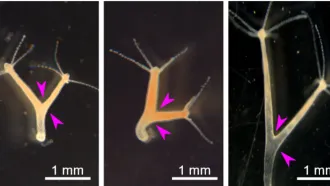
Scientists believe that studying the specific endothelial cells found in different organs of human body can lead to insights into the function and diseases associated with each organ.
Human body is nourished by an elaborate network of blood vessels that bring in nutrients and remove wastes from organs like the brain and heart. This marvellous plumbing system is uniquely adapted to the needs of each organ and these adaptations are reflected in the cells that line the inner walls of blood vessels. These inner lining cells, called endothelial cells, bear unique signatures and features in each organ. For example, the endothelial cells in blood vessels around the brain form what is known as the blood-brain barrier which prevents disease-causing microorganisms and harmful molecules from entering our brains.
Dr. Chinmoy Patra, a scientist at the Agharkar Research Institute in Pune, is interested in the specific type of endothelial cells found in the heart – cardiac endothelial cells.
In a new study, Dr. Patra and his colleagues examined the cellular components of the hearts of zebrafish (Danio rerio), a powerful model organism for organ development and regeneration studies.
“It is well known that mammalian hearts cannot regenerate after injury, while zebra fish hearts can. For the first time, we describe the cellular composition of the adult zebra fish cardiac ventricle.” says Dr. Patra, describing his interest in zebrafish. The study aimed at providing insights into the role of cardiac endothelial cells in heart development and disease.
Scientists have previously speculated that mammals show poor heart regeneration due to the high abundance of a cell type called fibroblasts, cells that produce collagen and other fibres, in the mammalian heart compared to zebrafish hearts. To shed more light on this, Dr. Patra and his colleagues compared the distribution of different cell types in the ventricles (one of the heart’s chambers) of zebrafish to that of the adult mouse – a mammal. They found that the composition of different cell types was similar in both cases, about two-fifths endothelial cells, two-fifths cardiomyocytes or heart muscle cells and the rest comprising other cell types including fibroblasts.
“This finding indicates that the lack of heart tissue regeneration in mammals is not due to the presence of high amount of cardiac fibroblast”, says Dr. Patra.
Although the percentage of endothelial cells was the same as in the mouse, the relative surface area of the ventricle covered by endothelial cells was significantly larger in zebra fish. The abundance of cardiac endothelial cells in the zebra fish allowed the researchers to establish an experimental method to isolate these cells with high purity. When asked about the novelty of their approach in isolating these cells, Dr. Patra said, “The novelty lies in the fact that we exploited the differences in attachment time required for the various cells found in the heart to enrich the final cell population for cardiac endothelial cells. This is very different from all existing protocols which rely on endothelial cell related antibodies to isolate endothelial cells.”
They also found that they could easily grow the isolated cells on petri dishes, a crucial ability that allowed them to perform further experiments on the cells in a controlled environment.
A battery of standard tests performed on the endothelial cells in petri dishes revealed a number of interesting features about them. One important test is the ability of cells to divide or proliferate in a dish. The cells passed this test with flying colours, showing robust proliferation in standard culture conditions.
Next, the researchers tested the migration capability of the cardiac endothelial cells. The ability of endothelial cells to migrate is indicative of their capability to form new blood vessels, which is an important part of tissue regeneration. The scientists created small wounds on a single layer of these cells and measured the reduction in the area of the wound over a 12 hour period. The cardiac endothelial cells covered approximately 80% of the initial cell-free area. This high rate of migration is a testament to the regenerative ability of the zebra fish heart.
The cultured cardiac endothelial cells were also subjected to tests which determined their usefulness in the screening of chemicals capable of influencing cell migration, and hence tissue regeneration. In these tests, the cells were treated with chemicals that acted as inducers and suppressors of cell migration. The data obtained from these tests revealed that the cardiac endothelial cells were responsive to chemical stimulation, making these systems useful for researchers to identify active compounds, genes or antibodies that are responsible for modulating particular functions. They may also aid in pharmacological studies with respect to drug discovery.
This study has laid the foundation for the development of new strategies that could promote heart regeneration in mammals. When asked about the feasibility of replicating this method on mammalian and possibly even human cell lines, Dr. Patra says, “It is feasible to use the protocol to isolate cardiac endothelial cells from other animal models. However, few steps might be necessary to adjust as per need.” This would be a huge step towards our understanding of heart diseases, their prognosis and treatment.






